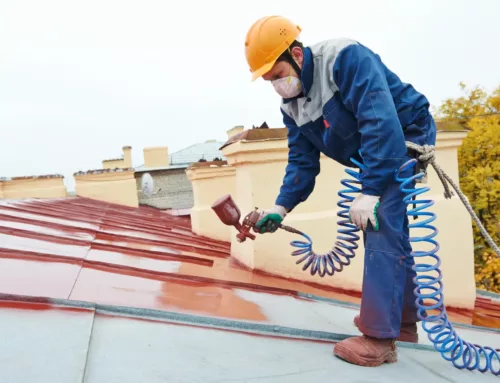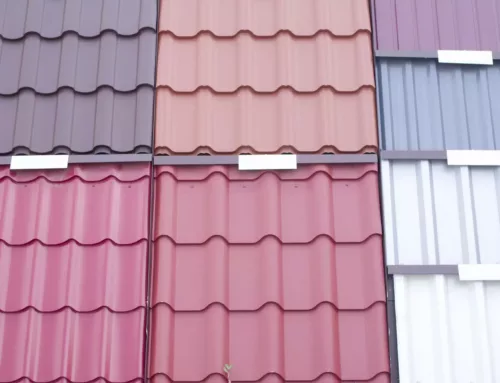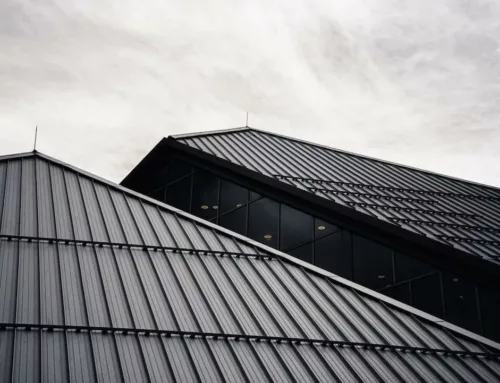Storms leave more than just a physical mark on our homes; they test our resilience. Immediate action becomes crucial when dealing with roof damage post-storm. This guide embarks on a journey “From Chaos to Calm,” emphasizing the urgency of prompt repairs. Waiting can exacerbate issues, leading to more severe consequences like leaks, structural damage, or even collapse. Our focus? To arm you with knowledge and steps for a swift, effective response, ensuring your safety and your home’s integrity. Embrace this guide as your first step towards restoring peace and protection under your roof.
Immediate Response to Storm Damage
Immediate Steps After the Storm
After a storm passes, assessing the condition of your roof is paramount. However, safety should always come first. Here’s a step-by-step guide to navigate this critical period with caution and efficiency.
- Stay Safe: Before anything, ensure it’s safe to go outside. Avoid walking under or near damaged tree branches and power lines.
- Visual Inspection: Conduct a ground-level visual inspection of your roof. Use binoculars if available. Look for visible signs of damage like missing shingles, metal pieces dislodged around the chimney, or debris accumulation.
- Document Everything: Take photos from a safe distance. Documenting the damage will be invaluable for insurance claims and contractor consultations.
- Prevent Further Damage: If it’s safe, use tarps to cover significant damages temporarily. This action prevents water from entering and causing more issues inside your home.
- Contact Professionals: Reach out to a trusted roofing contractor for a detailed inspection. They can offer an accurate assessment and discuss the next steps for repairs.
- Insurance Notification: Inform your insurance company about the damage as soon as possible. Early communication is key to a smooth claim process.
Following these steps swiftly can significantly mitigate the impact of storm damage on your roof, paving the way for a smoother repair process.
Handling Severe Damage: Roof Blow-offs or Collapses
In cases where a storm leads to a roof being blown off or a collapse, the approach must be handled with utmost urgency and care.
- Evacuate Safely: First, ensure everyone’s safety by evacuating the affected area or property. Stay clear of the damaged structure to avoid injuries from unstable debris or potential collapses.
- Emergency Services: Contact emergency services immediately to report the situation. They can provide necessary assistance and advice on safety measures.
- Secure the Property: If possible and safe, secure your property to prevent further damage or loss. However, prioritize safety over property.
- Contact Your Insurance: After ensuring everyone’s safety, contact your insurance provider to report the severe damage. They’ll guide you through the emergency claims process.
- Professional Assessment: Once it’s safe, have a professional roofing contractor assess the damage. They can provide a temporary solution to protect your property from further damage and plan for reconstruction.
- Stay Informed: Keep communication lines open with your insurance company, contractor, and any emergency services involved. Staying informed and responsive is crucial during the reconstruction process.
Facing such extreme damage can be overwhelming, but taking decisive, informed actions helps in navigating the aftermath more effectively, ensuring the safety of all occupants and the swift recovery of your property.
Weather Woes: The Costly Consequences

- Hailstorms: Over $10B damage annually.
- Tropical Cyclones: Avg. cost $20.3B/even.
- Roof Repairs: Avg. $1,10.
- Hurricanes: Katrina & Harvey each caused $125.
📈 By the Numbers:
- Tropical Cyclones: $20.3B
- Drought/Heat Waves: $9.7B
- Wildfires: $6B
- Flooding: $4.6B
- Winter Storms: $3.9B
- Severe Storms: $2.3B (most frequent).
🏠 Preventive Measures:
- Invest in weather-resistant home upgrades.
- Review and update insurance coverage regularly.
🔍 Did You Know?
- Every U.S. state has experienced a billion-dollar disaster.
- Texas has the highest number of hail events .
Identifying Types of Roof Damage
Roofs, our homes’ protectors, can suffer from various damages, especially due to weather events. Understanding these damages can help you respond effectively, preserving your roof’s integrity and your home’s safety.
Wind, Hail, Standing Water, and Debris Damage
- Wind Damage: Strong winds can dislodge or remove shingles, tear off flashing, and even lift sections of your roof. Post-storm, inspect your roof for signs like missing shingles or damaged flashing to prevent further damage.
- Hail Damage: Hail can be particularly destructive, denting shingles, dislodging granules, and even causing cracks. The impact varies with hail size and roof material but often leads to compromised UV protection and potential leaks.
- Water Damage: Heavy rain can exploit any weakness in your roof, leading to leaks and structural damage. Look for signs like buckling or curling shingles, and address minor issues quickly to prevent widespread damage.
- Debris Damage: Storms can hurl debris like branches or rocks at your roof, causing punctures or other physical damage. Post-storm, check for visible impacts, including broken or missing shingles and damaged flashing.
What Does a Damaged Roof Look Like? A Visual Guide to Recognizing Damage
Identifying roof damage early can save you from extensive and costly repairs. Here are signs to watch for:
- Granule Loss: Granules protect shingles from UV rays. If you find granules in gutters or see bald spots on shingles, it’s a sign of damage.
- Missing or Damaged Shingles: High winds or physical impacts can remove or damage shingles, exposing your roof to water ingress.
- Cracked or Curling Shingles: Age, hail, or improper installation can cause shingles to crack or curl, reducing their effectiveness.
- Pooling Water or Sagging: Indicates a severe issue, possibly a structural problem, requiring immediate professional attention.
- Damaged Flashing: Essential for waterproofing around roof penetrations; if damaged, it can lead to leaks.
- Mold or Algae Growth: Often results from long-term moisture issues and can indicate hidden water damage.
Insurance Claims and Contractor Selection
Navigating the complex world of insurance claims for roof damage while selecting the right contractor can be daunting. Here’s a concise guide to help homeowners through the process efficiently.
Navigating the Insurance Claim Process
1. Document the Damage: Start by taking clear photos or videos of the roof damage from multiple angles. This visual evidence is crucial for your insurance claim.
2. Review Your Policy: Understand what your homeowners insurance covers. Typically, storm, fire, vandalism, and damage from falling objects are covered, while wear and tear or neglect are not.
3. Contact Your Insurance Company: File a claim promptly, providing detailed information about the damage and supporting it with your documentation.
4. Inspection: An adjuster will inspect your roof to assess the damage. Be present during the inspection to ensure all areas of concern are noted.
5. Negotiate if Necessary: If the settlement offered by the insurance doesn’t seem fair, don’t hesitate to negotiate. Provide additional evidence or quotes if needed.
6. Approval and Settlement: Once approved, you’ll receive a settlement. Review the terms before proceeding with repairs.
Choosing Your Own Roofing Contractor
1. Get Multiple Quotes: After the insurance adjuster’s report, obtain several estimates from reputable contractors to ensure a fair price for the roof repair or replacement.
2. Check Credentials: Select a licensed, insured, and experienced contractor. Verify their credentials and ask for references.
3. Avoid Premature Contracts: Don’t sign any contracts or agreements until you have a clear settlement from your insurance. This prevents locking yourself into an agreement before knowing the insurance outcome.
4. Contractor-Insurance Communication: Some contractors offer to communicate with your insurance company on your behalf. This can simplify the process but ensure transparency and that you are kept in the loop.
5. Deductible and Payment: Be wary of contractors offering to pay your insurance deductible or proposing deals that seem too good to be true. This can be a red flag for unethical business practices.
Repair Process and Decision Making
Can I Repair the Roof Myself?
Deciding whether to repair your roof on your own involves weighing the benefits against potential risks. DIY repairs can offer cost savings and the satisfaction of personal accomplishment. However, they come with significant safety risks, especially for those inexperienced with roofing work. Furthermore, inadequate repairs due to a lack of professional expertise could lead to more severe issues, potentially voiding material warranties .
Repair or Replace?
The decision to repair or replace your roof hinges on several factors. Minor issues like a few missing shingles can often be repaired, but extensive damage might necessitate a full replacement. Key considerations include the age of your roof, the extent of damage, and the cost implications of both options. Professional assessments can provide clarity, helping you avoid the domino effect of minor damages escalating into major ones. It’s essential to consider long-term value and not just immediate costs when making this decision.
The Role of Insurance in Roof Repairs
Understanding what your insurance covers is crucial when facing roof repairs. Most policies cover damage from natural disasters, but not wear and tear or maintenance issues. Initiating a claim involves documenting the damage, reviewing your policy, and possibly obtaining professional estimates for repair or replacement costs. While DIY repairs might seem appealing for minor damages, they could complicate insurance claims or void warranties. Thus, engaging professionals for significant repairs not only ensures quality but may also align better with insurance requirements .
Maintenance and Prevention
Maintaining your roof is crucial to ensure it remains in good condition, protecting your home from weather-related damages. Here are some tips on how to save your roof from rain and extend its lifespan through regular maintenance.
How Can I Save My Roof from Rain?
Protecting your roof from rain involves a few proactive steps:
- Complete Necessary Repairs: Address any existing issues like torn or missing shingles, leaks, and damaged gutters promptly to avoid further damage from rain.
- Gutter Maintenance: Ensure gutters are clean and functioning correctly to prevent overflow and water damage.
- Inspect Flashing: Check and maintain flashing around skylights and other roof penetrations to prevent leaks.
- Professional Inspections: Schedule annual inspections with a roofing professional to identify and resolve any issues before they escalate.
Regular Maintenance Tips
Regular maintenance is key to extending your roof’s lifespan and preparing it for future storms:
- Routine Inspections: Conduct periodic inspections for signs of damage or wear and address them immediately.
- Debris Removal: Keep your roof free from debris like leaves and branches that can retain moisture and cause damage.
- Tree Management: Trim trees and bushes near your roof to prevent damage from overhanging limbs and to reduce the risk of mold and algae growth.
- Interior Checks: Don’t forget to inspect the interior of your roof for any signs of leaks or water damage.
- Proactive Repairs: Stay ahead of leaks by repairing any detected deterioration early, thus saving on emergency repairs and extending your roof’s life.
FAQs and Practical Guides
Can a Roof be Repaired from Inside?
Yes, temporary repairs can be done from the inside to mitigate water damage until professional repairs can be made. Identifying the leak and using materials like tar or roof patching with caulk are common steps for an inside repair.
Why Do Roofs Get Damaged?
Roofs can get damaged due to several reasons including weather exposure (hail, wind, rain), clogged gutters, flashing issues, ice dams, and physical damage from debris or overhanging tree branches.
How Long Should a Roof Last?
The lifespan of a roof depends on the material, installation quality, and maintenance. Generally, asphalt shingles last 15-30 years, while metal and tile roofs can last 50 years or more with proper care.
How Do You Fix a Rooftop?
Fixing a rooftop involves identifying the problem areas such as damaged shingles or flashing and replacing them. For leaks, it may include sealing around roof penetrations or applying waterproof coatings.
When Should I Worry About My Roof?
Signs of urgent problems include sagging ceiling, widespread shingle damage, significant leaks, and visible structural damage. Addressing issues promptly can prevent further damage.
Waterproofing and Leak Prevention
To keep your roof watertight, ensure regular maintenance like cleaning gutters, inspecting and replacing damaged shingles or tiles, ensuring proper attic ventilation, and applying waterproof sealants or membranes where necessary.
Advanced Tips and Insights
Innovative Roofing Materials
- Solar Reflective Shingles: Reduce heat absorption, cooling your home.
- Green Roofing: Supports sustainability with plant growth.
- Metal Roofs: Durable, fire-resistant, and energy-efficient.
- Composite Shingles: Eco-friendly, made from recycled materials.
Diagnosing Ceiling Leaks After Heavy Rain
- Check for Damage: Inspect shingles, gutters, and flashing.
- Signs: Look for water stains, mold, and peeling paint.
- Action: Clear gutters, repair damage, consider a professional inspection.
Conclusion
Navigating roof repairs after storm damage requires vigilance and prompt action. Recognizing the signs of damage, understanding the insurance claim process, and choosing the right contractor are essential steps in this journey. Additionally, embracing advanced roofing materials and regular maintenance can significantly enhance your roof’s durability and longevity.
By staying informed and proactive, homeowners can ensure their roofs remain robust protectors of their homes. Remember, a well-maintained roof is not just about safeguarding against the elements; it’s about ensuring peace of mind in the face of nature’s unpredictability.







